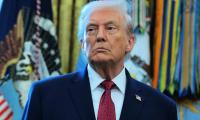IIOJK: the myth of normalcy
They also represented a breach of promise made by Indian prime minister Nehru to Kashmiris
August 5 marks the fifth anniversary since the Modi government abrogated Articles 370 and 35(a) of the Indian constitution and claimed to merge Indian Illegally Occupied Jammu and Kashmir (IIOJK) with India.
The illegal, immoral and unilateral actions by the right-wing BJP government, which drew widespread condemnation, were in contravention of the relevant UN Security Council’s resolutions, international law, and the bilateral treaties between India and Pakistan. They also represented a breach of the promise made by Indian prime minister Nehru to the Kashmiris.
Even though Article 370 was progressively weakened by a series of legislation from 1953 onwards, it still gave a semi-autonomous status to Jammu and Kashmir – a flag, constitution and laws. Article 35A recognized Kashmiris’ exclusive rights on their land, education and jobs. Together, these articles established a distinct and unique political identity of Kashmiris and hence were a thorn in the eyes of those who sought to turn India into a Hindu-only country.
As the revocation of the limited autonomy gave way to a series of political, economic, demographic and economic changes in IIOJK and put the Indian government at the centre of global attention for gross human rights violations, Indian Prime Minister Narendra Modi came up with a slogan of development, modernity and an end to violence.
There was a clear method to Mr Modi’s madness. By employing the slogan of development, he sought to blunt the mounting international criticism over the rights abuses and the implementation of draconian measures. The governing principle of such a shrewd strategy was to present the uprising in IIOJK as an internal law-and-order problem, which was caused by the deprivation of economic opportunities.
At home, the Modi government presided over a slew of measures that represented the implementation of a fundamental policy in the ruling BJP’s manifesto, which scholars of the Jammu and Kashmir dispute have described as the ‘final solution’. This ‘final solution’ has been aimed at altering the political reality of Jammu and Kashmir in a way that deprives Kashmiris of their UN-sanctioned right to self-determination.
The Indian government’s campaign in IIOJK, driven by the ‘Hindutva’ ideology, promotes Hindu supremacy and targets Muslims, leading Genocide Watch to warn of potential genocide. Since August 2019, censorship and surveillance have intensified, with journalists, lawyers, human rights defenders, and Kashmiri political leaders being routinely harassed and accused of terrorism for reporting human rights abuses.
Violence has been normalized, with generations growing up amid insecurity and psychological and emotional trauma. Human rights organizations have documented the use of rape and sexual assault by Indian security forces as a weapon of war.
Special draconian laws were enacted to grant impunity to Indian forces. To erase Kashmiris’ ethno-religious identity, cultural and religious sites have been destroyed over the last five years. India is also implementing illegal demographic changes to convert IIOJK’s Muslim majority into a Hindu majority, issuing over four million fake domicile certificates to Hindus and confiscating Kashmiri land for military use, in violation of international law, including the Fourth Geneva Convention.
These rights abuses, which were duly highlighted by the international media and human rights organizations in their numerous reports, articles and investigative stories, took place as Mr Modi embarked on his ‘hug’ diplomacy to charm world leaders with a promise of India as a counterweight to China and large market potential.
Meanwhile, the Indian leadership made a consistent effort to craft a ‘normalcy’ mantra to evade greater international scrutiny of the government’s actions. Even Mr Modi has been seen singing praises of the infrastructure projects and so-called economic initiatives during his sporadic visits to the restive valley before and after the elections.
Deserving of particular mention is how Indian media outlets were co-opted by a combination of the appeal of the Hindutva ideology and the crony big business to sell the false and misleading myth of normalcy. The media obediently reported, neglecting its fundamental duty of holding the executive to account and showing both sides of the picture.
The Modi government also ran special campaigns to present Occupied Jammu and Kashmir as a lucrative tourist attraction to both international and local tourists. The visits of high-profile entertainment celebrities and political and religious figures were given prominent publicity. So much so that the government chose IIOJK as a venue for one of the G20 meetings, including arranging state-managed visits of a select group of New Delhi-based European diplomats.
Even recently held elections in IIOJK where the BJP did not dare field its candidates for fear of drubbing were portrayed as a return of the region to normalcy. Mr Modi continued harping on the mantra of how his government’s actions on August 5 brought IIOJK to par with other regions through what he termed ‘significant investments in development initiatives’.
The fake normalcy narrative also includes the holding of different cultural and sports events that the compliant media has often reported as demonstrating the return of normalcy and greater community participation.
In trying to sell the myth of normalcy, the Modi government has also indulged in information manipulation as well as playing legal gimmicks. Little wonder the busting of the vast clandestine Indian disinformation network by EU DisInfo Lab in 2021 showed how India has leveraged information as a tool to shape (mis)perceptions of the wider world.
Likewise, the decision of the Indian Supreme Court whereby it okayed the revocation of Article 370 was projected as putting a seal of approval on the legality of the government’s actions. It is a different matter that the decision of the top Indian court is of little legal consequence, as it cannot supersede the UN Security Council resolutions and international law when it comes to the question of the right to self-determination.
The reality on the ground in IIOJK belies the tall claims of progress, development and modernity. The fact remains that the withdrawal of Articles 370 and 35A has led to an entrenched feeling of disenfranchisement among Kashmiris. There is widespread discontent and frustration in the local population.
IIOJK remains the world’s most militarized region with over 900,000 regular troops deployed there. Everyday life for a resident means an atmosphere of intimidation, surveillance, enforced disappearances, torture, rape, curfews and restrictions on the exercise of fundamental rights.
Reports after reports have confirmed that violations of human rights are a regular recurrence in Jammu and Kashmir. The climate of fear is marked by arbitrary detentions, crackdowns on dissent, and imprisonment for citizens, activists and journalists alike.
Free speech is heavily suppressed through the application of special laws, media censorship and intense pressure on local journalists to adhere to the government’s narrative. Internet shutdowns and communication blackouts are common, severely limiting the flow of information and isolating the region from the rest of the world.
Despite the Indian government’s claims of economic development, the local population often does not see the benefits. Economist Jean Dreze has noted that Article 370 was in fact instrumental in ensuring the economic development of Jammu and Kashmir at par with other regions. The dismantling of the feudal structure in the 1950s led to an improvement in people’s socio-economic conditions. As a result of frequent blockades and political instability, businesses have struggled, leading to high unemployment and economic stagnation.
Political repression is evident, with mainstream political leaders and parties frequently sidelined in favour of pro-India political actors. Even these leaders have also faced imprisonment for objecting to the Indian government’s actions.
Cultural and religious symbols are under attack, and religious practices are frequently disrupted by security measures and curfews. The ongoing political and security situation has exacerbated social tensions and mistrust between different communities.
The Modi government is implementing a settler-colonial project in IIOJK, and the carefully crafted narrative of ‘development’ and ‘normalcy’ provides a fig leaf to mask the ugly reality that marks life in IIOJK.
The writer is an alumnus of the University of Sussex and has a degree in international
journalism. He tweets/posts @Amanat222
-
 How King Charles Is Reacting To Abdication Rumours, Prince William's Succession Talks?
How King Charles Is Reacting To Abdication Rumours, Prince William's Succession Talks? -
 Space Race Intensifies As Russia Plans Lunar Nuclear Power Plant By 2036
Space Race Intensifies As Russia Plans Lunar Nuclear Power Plant By 2036 -
 Italy Orders Meta To Suspend WhatsApp Terms Prohibiting Rival AI Chatbots
Italy Orders Meta To Suspend WhatsApp Terms Prohibiting Rival AI Chatbots -
 Serena Williams Surprises Sister With Most Expensive Wedding Gift
Serena Williams Surprises Sister With Most Expensive Wedding Gift -
 Kris Jenner Names Kardashian-Jenner Who Is The ‘hardest’ To Get Gifts For
Kris Jenner Names Kardashian-Jenner Who Is The ‘hardest’ To Get Gifts For -
 Should Meghan Markle, Prince Harry Return To The UK For Christmas? Royal Fans Give Verdict
Should Meghan Markle, Prince Harry Return To The UK For Christmas? Royal Fans Give Verdict -
 Prince Harry, Meghan Markle Emotional Moment With Injured Dog Revealed
Prince Harry, Meghan Markle Emotional Moment With Injured Dog Revealed -
 Scientist Find New Clue To Spot Mental Health Risk
Scientist Find New Clue To Spot Mental Health Risk -
 UFO Expert Makes Startling Revelation About Interaction With Aliens
UFO Expert Makes Startling Revelation About Interaction With Aliens -
 Prince Harry 'determined' To Secure Stable Future For Archie, Lilibet Away From Crown
Prince Harry 'determined' To Secure Stable Future For Archie, Lilibet Away From Crown -
 Trump Flew On Epstein Jet Eight Times In 90s, Prosecutor Email Claims
Trump Flew On Epstein Jet Eight Times In 90s, Prosecutor Email Claims -
 Prince George Creates Style-stir Following Kate Middleton's 'effect'
Prince George Creates Style-stir Following Kate Middleton's 'effect' -
 Changing Cervical Cancer’s Future: Who Gets The HPV Vaccine?
Changing Cervical Cancer’s Future: Who Gets The HPV Vaccine? -
 King Charles’ Look For His Christmas Day Broadcast Released: ‘All Ruddy-cheeked And Smiling’
King Charles’ Look For His Christmas Day Broadcast Released: ‘All Ruddy-cheeked And Smiling’ -
 Ice Spice Sets Record Straight On Rumoured Beef With Latto
Ice Spice Sets Record Straight On Rumoured Beef With Latto -
 TikTok's ByteDance To Offer 50% Bonus For High Performers In 2026
TikTok's ByteDance To Offer 50% Bonus For High Performers In 2026




